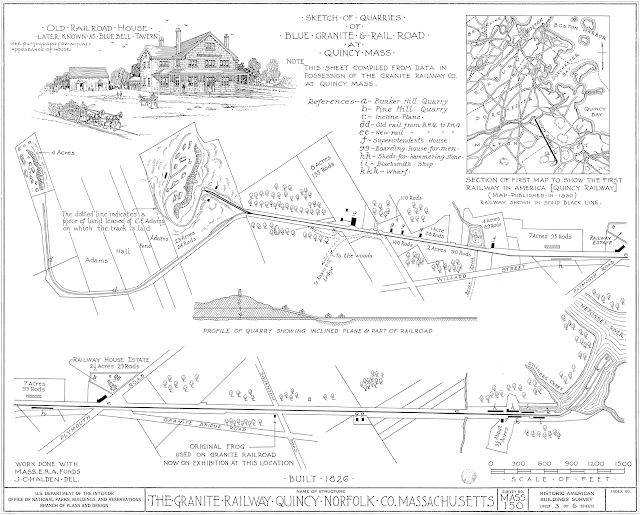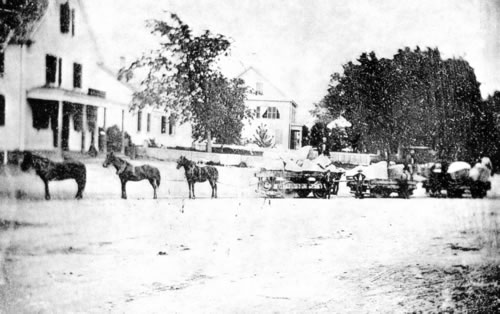The Granite Railway in Quincy, Massachusetts
One of the First Railways in the United States was the Granite Railway first constructed and opened in 1826, after six months of construction. As one of the first built in the US, outside of preserved sections and memorials, no trace of the route exists today.
The railroad's construction showed promise of the new technology, which at the time was met with skepticism, as the canal was the preferred form of transit at the time, having been proven by such large projects as the Erie Canal.
 |
| US Department of the Interior Map, Wikipedia Commons |
While predated by the Leiper Railway, this may have been the first chartered common-carrier railroad in the United States, but there are quite a few operations that can lay at least some claim to being the 'first' railroad in the US.
 |
| A three-car, horse-drawn train on the Granite Railway at East Milton Square c1855. (Wikipedia Commons) |
Aptly named to transport granite from Quincy, MA to the Neponset River at Milton, about 4 miles south. One of the earliest railroad pioneers in the United States was responsible for its construction, that being Gridley Bryant, who would later tell the story of the line decades later.
 |
| Image: 1934 Preservation of the Inclined portion of the Granite Railway (ASCE). |
In an 1859 letter to Charles B. Stuart on the railway, Gridley wrote, "The Quincy Railway was commenced under the following circumstances: The 'Bunker Hill Monument Association' had been formed, and funds enough collected to commence the foundation of the monument in the spring of eighteen hundred and twenty-five. I aided the architect in preparing the foundation, and on the seventeenth day of June following, the corner-stone was laid by General de La Fayette, and I had the honor to assist as master builder at the ceremony. I had, previous to this, purchased a stone quarry (the funds being furnished by Dr. John C. Warren) for the express purpose of procuring the granite for constructing this monument. This quarry was in Quincy, nearly four miles from water-carriage. This suggested to me the idea of a railroad (the Manchester and Liverpool Railroad being in contemplation at that time, but was not begun until the spring following); accordingly, in the fall of eighteen hundred and twenty-five, I consulted Thomas H. Perkins, William Sullivan, Amos Lawrence, Isaac T. Davis, and David Moody, all of Boston, in reference to it. These gentlemen thought the project visionary and chimerical, but, being anxious to aid the Bunker Hill Monument, consented that I might see what could be done. I awaited the meeting of our Legislature in the winter of eighteen hundred and twenty-five and six, and after every delay and obstruction that could be thrown in the way, I finally obtained a charter, although there was great opposition in the House. The questions were asked: 'What do we know about rail-roads? Who ever heard of such a thing? Is it right to take people's land for a project that no one knows anything about? We have corporations enough already.' Such and similar objections were made, and onerous restrictions were imposed, but it finally passed by a small majority only. Unfavorable as the charter was, it was admitted that it was obtained by my exertions; but it was owing to the munificence and public spirit of Colonel T. H. Perkins that we were indebted for the whole enterprise. None of the first named gentlemen ever paid any assessments, and the whole stock finally fell into the hands of Colonel Perkins.
The Quincy Railroad [The Granite Railway] is four miles long, including the branches. I surveyed several routes from the quarry purchased (called the Bunker Hill Quarry), to the nearest tide-water; and finally the present location was decided upon. I commenced the work on the first day of April, eighteen hundred and twenty-six, and on the seventh day of October following the first train of cars passed over the whole length of the road.
The deepest cutting was fifteen feet, and the highest elevation above the surface of the ground was twelve feet. The several grades were as follows: The first, commencing at the wharf or landing, was twenty-six feet to the mile, the second thirteen feet, and the third sixty-six feet. This brought us to the foot of the table-lands that ran around the main quarry; here an elevation of eighty-four feet vertical was to be overcome. This was done by an inclined plane, three hundred and fifteen feet long, at an angle of about fifteen degrees. It had an endless chain, to which the cars were attached in ascending or descending; at the head of this inclined plane I constructed a swing platform to receive the loaded cars as they came from the quarry. This platform was balanced by weights, and had gearing attached to it in such a manner that it would always return (after having dumped) to a horizontal position, being firmly supported on the periphery of an eccentric cam. When the cars were out on the platform there was danger of their running entirely over, and I constructed a self-acting guard, that would rise above the surface of the rail upon the platform as it rose from its connection with the inclined plain, or receded out of the way when the loaded car passed on to the track; the weight of the car depressing the platform as it was lowered down.
I also constructed a turn-table at the foot of the quarry, which is still in use as originally constructed. The railroad was continued at different grades around the quarry, the highest part of which was ninety-three feet above the general level; on the top of this was erected an obelisk or monument forty-five feet high.
The road was constructed in the following manner: Stone sleepers were laid across the track eight feet apart. Upon these, wooden rails, six inches thick and twelve inches high, were placed. Upon the top of these rails, iron plates, three inches wide and one-fourth of an inch thick, were fastened with spikes ; but at all the crossings of public roads and drift-ways stone rails were used instead of wood. On the top of these were placed iron plates four inches wide and half an inch thick, being firmly bolted to the stone. The inclined plane was built in the same permanent manner and had a double track.
The first cost of the road was fifty thousand dollars, and that of the first car six hundred dollars. This car had high wheels, six and one-half feet in diameter, the load being suspended on a platform by chains under the axles. This platform was let down at any convenient place and loaded ; the car was then run over the load, and the chains attached to it by being inserted in eye-bolts in the platform, and raised a little above the track by machinery on the top of the car. The loads averaged about six tons each. The next car was. made with low wheels, with a strong massive frame. The gauge of the road being five feet, the axles were placed that distance apart, this being the true principle on which to construct railroad trucks, and has been adopted generally in this country.
When stones of eight or ten tons weight were to be transported, I took two of these trucks and attached them together by a platform and king bolts. This made an eight-wheeled car; and when larger stones were to be carried, I increased the number of trucks, and this made a sixteen-wheeled car...."
Today at East Milton Square lies a memorial to the Granite Railway.
| Granite Railway Marker. Image: Pi on Wikipedia Commons |
Thanks as always for reading!



Comments
Post a Comment